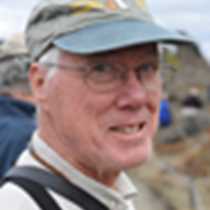Central and Eastern Svalbard, Norway
It was a day for collectives. It began even before breakfast as National Geographic Explorer was making its way southward down Hinlopen Straits, a narrow body of water that separates the two large islands of Spitsbergen and Nordauslandet. We stopped at Cape Fanshawe to view the incredible breeding seabird colony of Alkefjellet. Here, some 100,000 pairs of Brünich's Guillemots (aka thick-billed murres) sit packed tightly, side-by-side, on narrow ledges, each pair tending a single young. Sheer numbers give them a measure of protection from marauding glaucous gulls, ever alert to snatch a chick from unwary parents. It takes all of the efforts of both adults to feed the single chick on a ledge. Soon, long before the chicks are fully grown and able to fly, they will jump from the ledges and flutter down to follow their fathers out to sea. Above the drone of thousands of guillemot adults, we could hear the higher-pitched, plaintive calls of young birds that have already made the jump of faith. Soon the colony will be deserted until next year, when the cycle will be repeated.
We continued on to Torellneset, on the coast of Nordaustlandet. There, we viewed a group of walrus on the beach. There seemed to be great interest in the correct plural and collective terms for walrus, so let's get that over. Walruses, or walrus; either is correct, but not walri, even if it is more fun to say. And a gathering of walrus is either a herd or a "buncha". We were viewing a whole buncha walrus, largely or entirely males, hauled out on the beach, each walrus leaning against its several neighbors in a thigmotactic horde. This behavior helps to keep the skin warm as they are moulting their sparse hair.
Seventy-five percent of Nordaustlandet is covered by the Austfonna Icecap, the largest in the world outside of Antarctica and Greenland. It is over 500 meters deep at its thickest point. Ice that is formed over the island pushes out from its own weight until it reaches the coast where it breaks off in abrupt, vertical cliffs. They extend, continuously, for over 100 miles. During summer, some of the surface ice melts and collects as freshwater streams that reach the edge of the icecap and spew out into the surrounding ocean.
We stopped; we viewed; we clicked; we continued through the fog, around southern Nordaustslandet and then northward along its eastern side, searching for the elusive shrinking Arctic sea ice. Thanks to modern satellite imagery, we know where to find it, far to the north. Between the ice and us was the island of Storøya (= "big island," although it really isn't all that big.) Following dinner, we climbed, once again, into all of our warm clothing and headed out in our Zodiacs for a cruise under the midnight sun. The attraction was soon apparent: hundreds of walrus, in the water all around us and hauled out on the adjacent shore. On land, walrus appear slow, clumsy, awkward; in the water they are altogether different: lithe, graceful, and in their true element. They seemed to be quite curious about our visit, repeatedly approaching our Zodiacs and rising up from the water as if craning their necks for better views of us. We saw walrus of all ages, judging from size and tusk development — from pups without tusks, swimming very close to their mothers, to much larger and toothier animals — evidence that this is a gathering of breeding walrus. Once, walrus were much more abundant in the waters around Svalbard. They were killed for their teeth, their hides, and their blubber. Now, they face a new threat: habitat loss from the diminishing of Arctic sea ice over their shallow-water feeding areas.




